Victorian Government: Crime Prevention and Justice Reinvestment Essay
VerifiedAdded on 2023/06/04
|14
|3825
|495
Essay
AI Summary
This essay addresses the rising incarceration rates and associated costs within the Australian criminal justice system, focusing on the Victorian state government. It advocates for increased investment in crime prevention and justice reinvestment as a strategic approach to reduce spending on police and corrections. The essay provides an overview of the concepts of Justice Reinvestment (JR) and crime prevention, their rationales, and implementation in other countries. It examines the problems of the Australian policing and correction system, including the rising costs and overcrowding in prisons. It explores the principles of proportionality and how they relate to human rights and the criminal justice system. The paper defines JR as a strategy to reduce correctional spending and reinvest in communities to reduce crime, discussing its four-step process and main themes. The essay provides examples of JR implementation in the US and highlights the positive impacts, such as reduced prison populations and financial reinvestment. The essay concludes by emphasizing the importance of evidence-based interventions and strategies for crime prevention, demonstrating how these approaches can be financially beneficial. It aims to convince the Victorian state government to adopt these strategies for a more cost-effective and efficient criminal justice system.
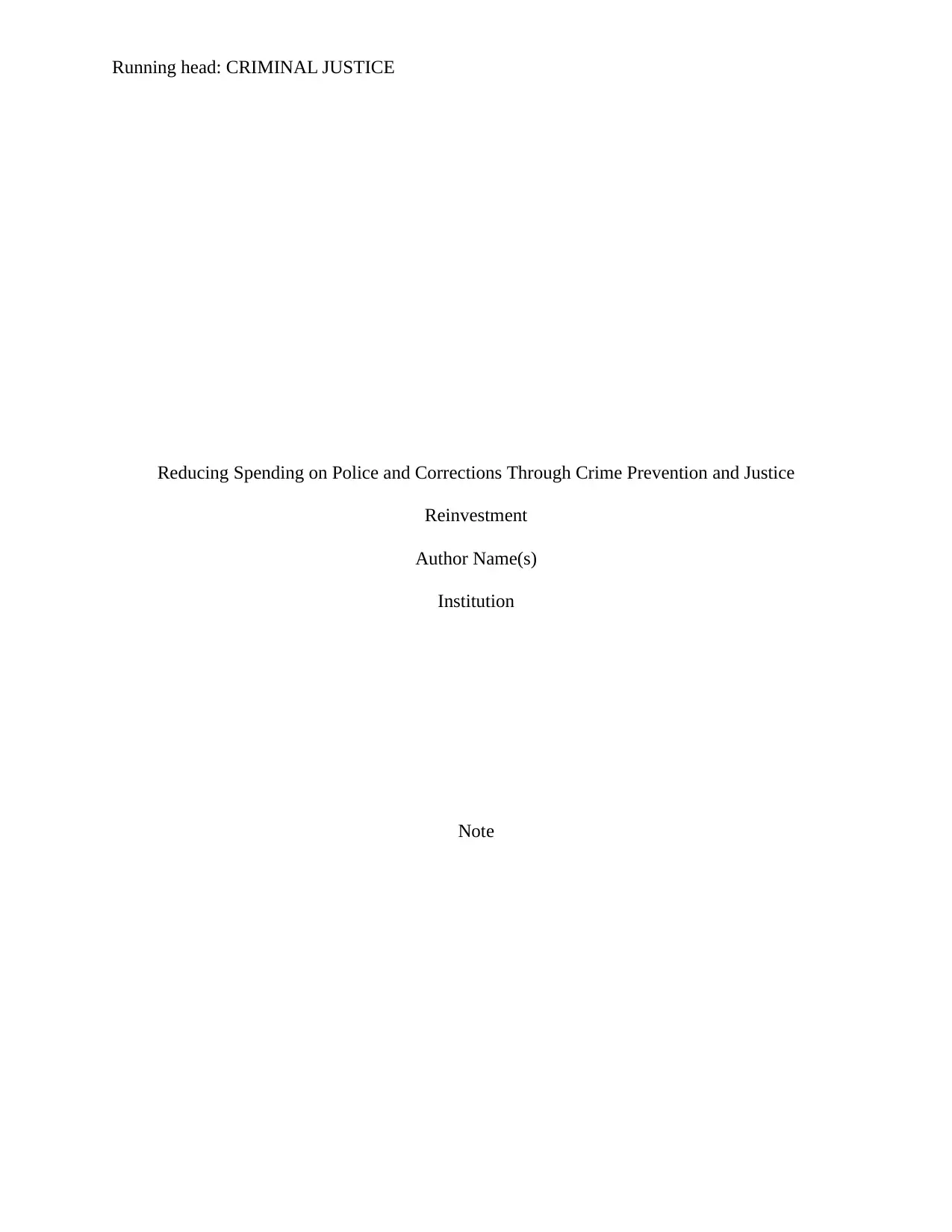
Running head: CRIMINAL JUSTICE
Reducing Spending on Police and Corrections Through Crime Prevention and Justice
Reinvestment
Author Name(s)
Institution
Note
Reducing Spending on Police and Corrections Through Crime Prevention and Justice
Reinvestment
Author Name(s)
Institution
Note
Paraphrase This Document
Need a fresh take? Get an instant paraphrase of this document with our AI Paraphraser
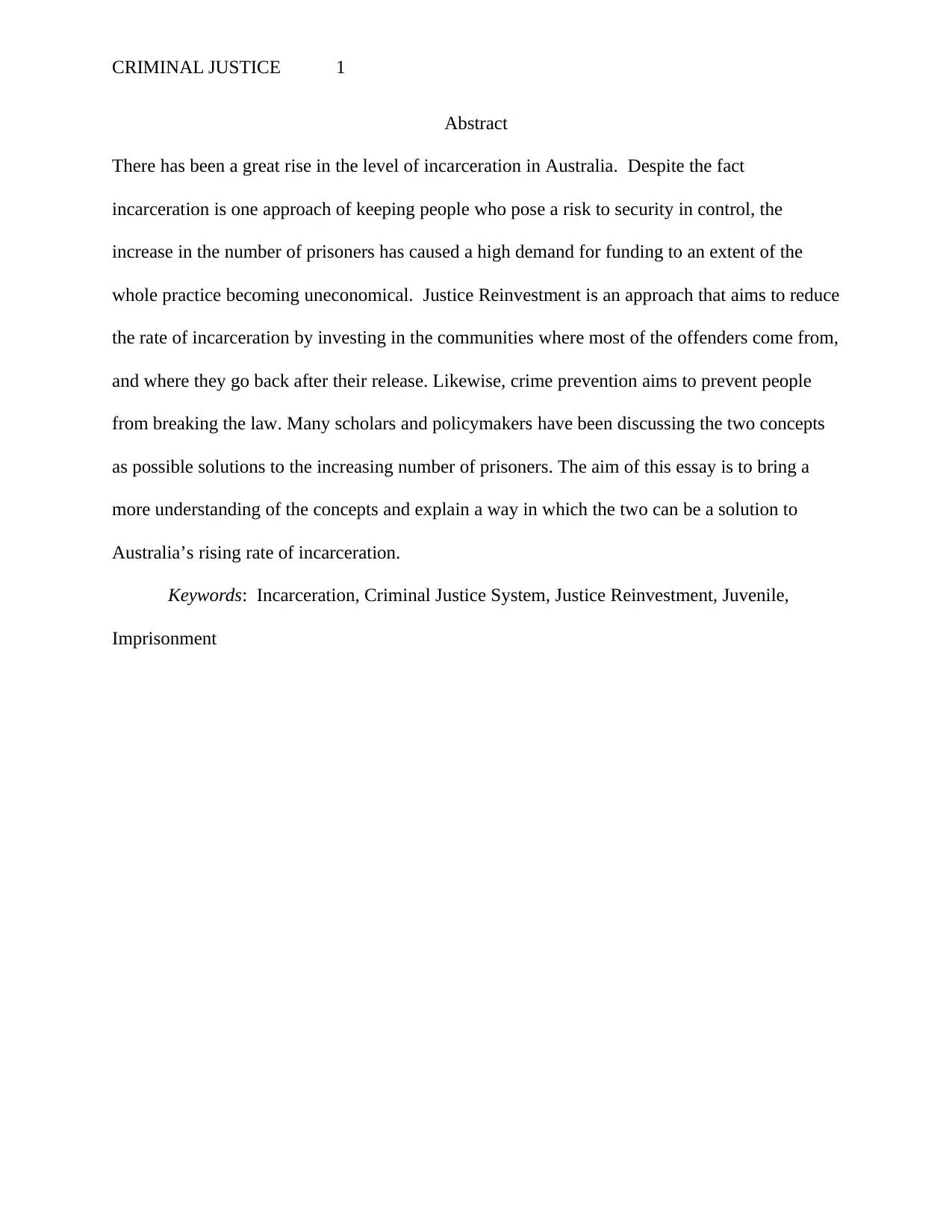
CRIMINAL JUSTICE 1
Abstract
There has been a great rise in the level of incarceration in Australia. Despite the fact
incarceration is one approach of keeping people who pose a risk to security in control, the
increase in the number of prisoners has caused a high demand for funding to an extent of the
whole practice becoming uneconomical. Justice Reinvestment is an approach that aims to reduce
the rate of incarceration by investing in the communities where most of the offenders come from,
and where they go back after their release. Likewise, crime prevention aims to prevent people
from breaking the law. Many scholars and policymakers have been discussing the two concepts
as possible solutions to the increasing number of prisoners. The aim of this essay is to bring a
more understanding of the concepts and explain a way in which the two can be a solution to
Australia’s rising rate of incarceration.
Keywords: Incarceration, Criminal Justice System, Justice Reinvestment, Juvenile,
Imprisonment
Abstract
There has been a great rise in the level of incarceration in Australia. Despite the fact
incarceration is one approach of keeping people who pose a risk to security in control, the
increase in the number of prisoners has caused a high demand for funding to an extent of the
whole practice becoming uneconomical. Justice Reinvestment is an approach that aims to reduce
the rate of incarceration by investing in the communities where most of the offenders come from,
and where they go back after their release. Likewise, crime prevention aims to prevent people
from breaking the law. Many scholars and policymakers have been discussing the two concepts
as possible solutions to the increasing number of prisoners. The aim of this essay is to bring a
more understanding of the concepts and explain a way in which the two can be a solution to
Australia’s rising rate of incarceration.
Keywords: Incarceration, Criminal Justice System, Justice Reinvestment, Juvenile,
Imprisonment
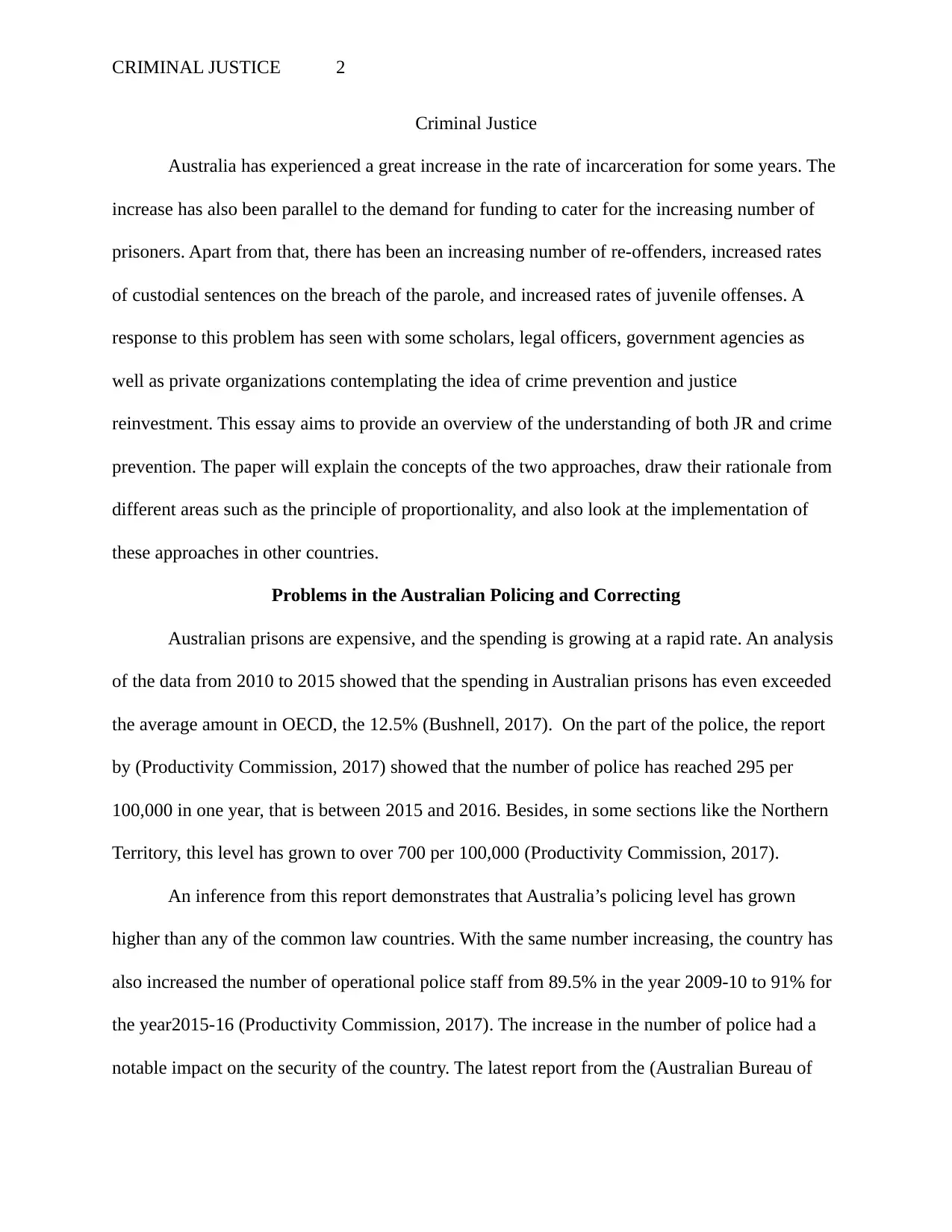
CRIMINAL JUSTICE 2
Criminal Justice
Australia has experienced a great increase in the rate of incarceration for some years. The
increase has also been parallel to the demand for funding to cater for the increasing number of
prisoners. Apart from that, there has been an increasing number of re-offenders, increased rates
of custodial sentences on the breach of the parole, and increased rates of juvenile offenses. A
response to this problem has seen with some scholars, legal officers, government agencies as
well as private organizations contemplating the idea of crime prevention and justice
reinvestment. This essay aims to provide an overview of the understanding of both JR and crime
prevention. The paper will explain the concepts of the two approaches, draw their rationale from
different areas such as the principle of proportionality, and also look at the implementation of
these approaches in other countries.
Problems in the Australian Policing and Correcting
Australian prisons are expensive, and the spending is growing at a rapid rate. An analysis
of the data from 2010 to 2015 showed that the spending in Australian prisons has even exceeded
the average amount in OECD, the 12.5% (Bushnell, 2017). On the part of the police, the report
by (Productivity Commission, 2017) showed that the number of police has reached 295 per
100,000 in one year, that is between 2015 and 2016. Besides, in some sections like the Northern
Territory, this level has grown to over 700 per 100,000 (Productivity Commission, 2017).
An inference from this report demonstrates that Australia’s policing level has grown
higher than any of the common law countries. With the same number increasing, the country has
also increased the number of operational police staff from 89.5% in the year 2009-10 to 91% for
the year2015-16 (Productivity Commission, 2017). The increase in the number of police had a
notable impact on the security of the country. The latest report from the (Australian Bureau of
Criminal Justice
Australia has experienced a great increase in the rate of incarceration for some years. The
increase has also been parallel to the demand for funding to cater for the increasing number of
prisoners. Apart from that, there has been an increasing number of re-offenders, increased rates
of custodial sentences on the breach of the parole, and increased rates of juvenile offenses. A
response to this problem has seen with some scholars, legal officers, government agencies as
well as private organizations contemplating the idea of crime prevention and justice
reinvestment. This essay aims to provide an overview of the understanding of both JR and crime
prevention. The paper will explain the concepts of the two approaches, draw their rationale from
different areas such as the principle of proportionality, and also look at the implementation of
these approaches in other countries.
Problems in the Australian Policing and Correcting
Australian prisons are expensive, and the spending is growing at a rapid rate. An analysis
of the data from 2010 to 2015 showed that the spending in Australian prisons has even exceeded
the average amount in OECD, the 12.5% (Bushnell, 2017). On the part of the police, the report
by (Productivity Commission, 2017) showed that the number of police has reached 295 per
100,000 in one year, that is between 2015 and 2016. Besides, in some sections like the Northern
Territory, this level has grown to over 700 per 100,000 (Productivity Commission, 2017).
An inference from this report demonstrates that Australia’s policing level has grown
higher than any of the common law countries. With the same number increasing, the country has
also increased the number of operational police staff from 89.5% in the year 2009-10 to 91% for
the year2015-16 (Productivity Commission, 2017). The increase in the number of police had a
notable impact on the security of the country. The latest report from the (Australian Bureau of
⊘ This is a preview!⊘
Do you want full access?
Subscribe today to unlock all pages.

Trusted by 1+ million students worldwide
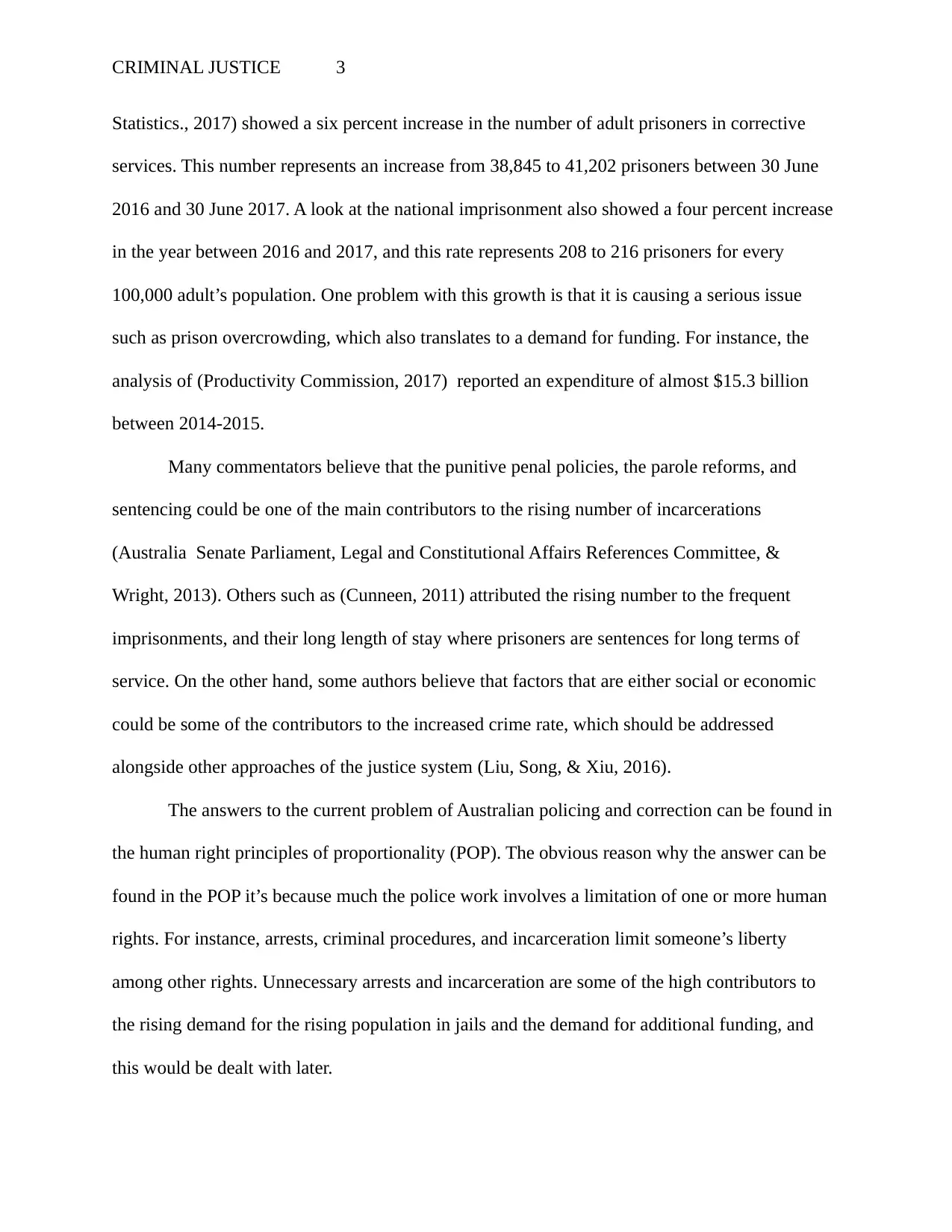
CRIMINAL JUSTICE 3
Statistics., 2017) showed a six percent increase in the number of adult prisoners in corrective
services. This number represents an increase from 38,845 to 41,202 prisoners between 30 June
2016 and 30 June 2017. A look at the national imprisonment also showed a four percent increase
in the year between 2016 and 2017, and this rate represents 208 to 216 prisoners for every
100,000 adult’s population. One problem with this growth is that it is causing a serious issue
such as prison overcrowding, which also translates to a demand for funding. For instance, the
analysis of (Productivity Commission, 2017) reported an expenditure of almost $15.3 billion
between 2014-2015.
Many commentators believe that the punitive penal policies, the parole reforms, and
sentencing could be one of the main contributors to the rising number of incarcerations
(Australia Senate Parliament, Legal and Constitutional Affairs References Committee, &
Wright, 2013). Others such as (Cunneen, 2011) attributed the rising number to the frequent
imprisonments, and their long length of stay where prisoners are sentences for long terms of
service. On the other hand, some authors believe that factors that are either social or economic
could be some of the contributors to the increased crime rate, which should be addressed
alongside other approaches of the justice system (Liu, Song, & Xiu, 2016).
The answers to the current problem of Australian policing and correction can be found in
the human right principles of proportionality (POP). The obvious reason why the answer can be
found in the POP it’s because much the police work involves a limitation of one or more human
rights. For instance, arrests, criminal procedures, and incarceration limit someone’s liberty
among other rights. Unnecessary arrests and incarceration are some of the high contributors to
the rising demand for the rising population in jails and the demand for additional funding, and
this would be dealt with later.
Statistics., 2017) showed a six percent increase in the number of adult prisoners in corrective
services. This number represents an increase from 38,845 to 41,202 prisoners between 30 June
2016 and 30 June 2017. A look at the national imprisonment also showed a four percent increase
in the year between 2016 and 2017, and this rate represents 208 to 216 prisoners for every
100,000 adult’s population. One problem with this growth is that it is causing a serious issue
such as prison overcrowding, which also translates to a demand for funding. For instance, the
analysis of (Productivity Commission, 2017) reported an expenditure of almost $15.3 billion
between 2014-2015.
Many commentators believe that the punitive penal policies, the parole reforms, and
sentencing could be one of the main contributors to the rising number of incarcerations
(Australia Senate Parliament, Legal and Constitutional Affairs References Committee, &
Wright, 2013). Others such as (Cunneen, 2011) attributed the rising number to the frequent
imprisonments, and their long length of stay where prisoners are sentences for long terms of
service. On the other hand, some authors believe that factors that are either social or economic
could be some of the contributors to the increased crime rate, which should be addressed
alongside other approaches of the justice system (Liu, Song, & Xiu, 2016).
The answers to the current problem of Australian policing and correction can be found in
the human right principles of proportionality (POP). The obvious reason why the answer can be
found in the POP it’s because much the police work involves a limitation of one or more human
rights. For instance, arrests, criminal procedures, and incarceration limit someone’s liberty
among other rights. Unnecessary arrests and incarceration are some of the high contributors to
the rising demand for the rising population in jails and the demand for additional funding, and
this would be dealt with later.
Paraphrase This Document
Need a fresh take? Get an instant paraphrase of this document with our AI Paraphraser
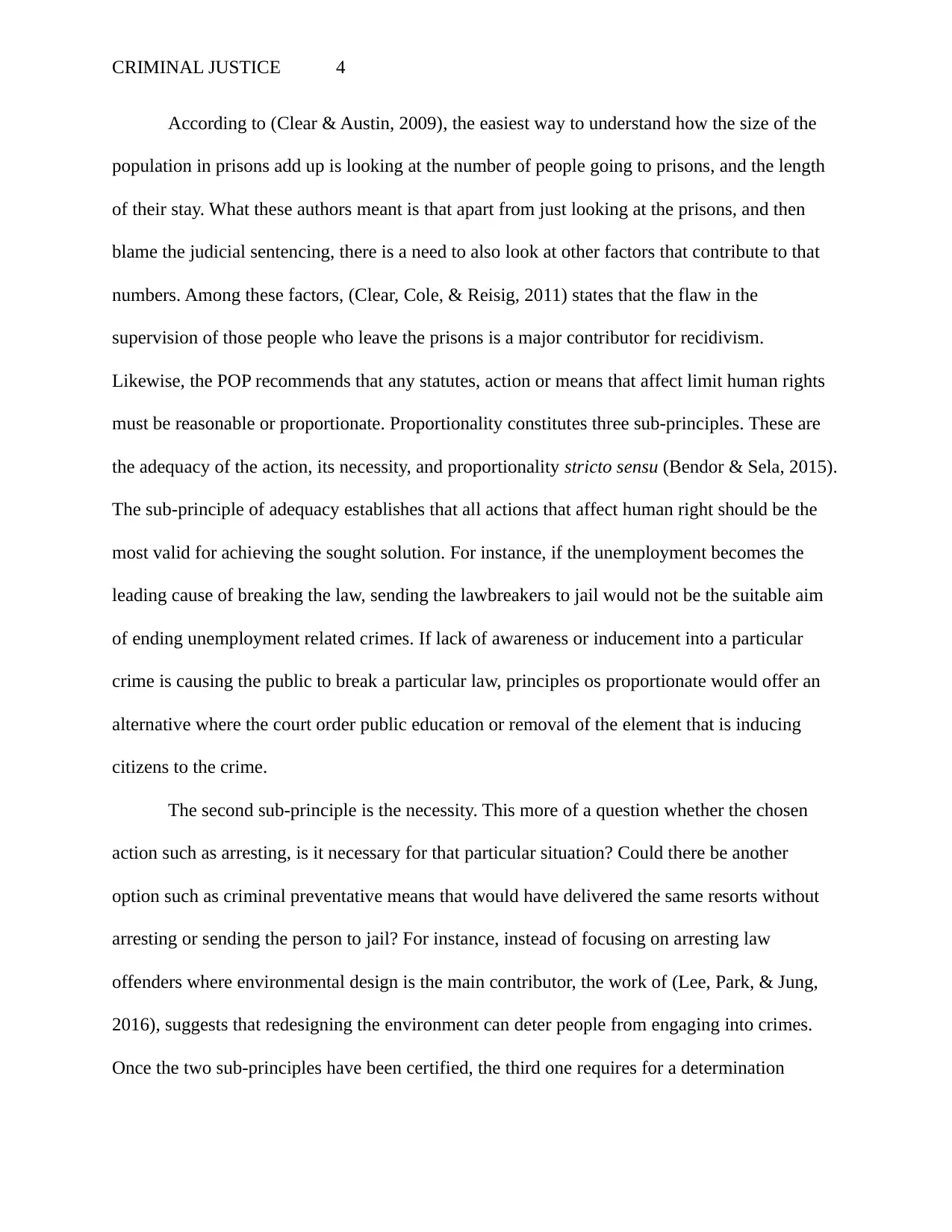
CRIMINAL JUSTICE 4
According to (Clear & Austin, 2009), the easiest way to understand how the size of the
population in prisons add up is looking at the number of people going to prisons, and the length
of their stay. What these authors meant is that apart from just looking at the prisons, and then
blame the judicial sentencing, there is a need to also look at other factors that contribute to that
numbers. Among these factors, (Clear, Cole, & Reisig, 2011) states that the flaw in the
supervision of those people who leave the prisons is a major contributor for recidivism.
Likewise, the POP recommends that any statutes, action or means that affect limit human rights
must be reasonable or proportionate. Proportionality constitutes three sub-principles. These are
the adequacy of the action, its necessity, and proportionality stricto sensu (Bendor & Sela, 2015).
The sub-principle of adequacy establishes that all actions that affect human right should be the
most valid for achieving the sought solution. For instance, if the unemployment becomes the
leading cause of breaking the law, sending the lawbreakers to jail would not be the suitable aim
of ending unemployment related crimes. If lack of awareness or inducement into a particular
crime is causing the public to break a particular law, principles os proportionate would offer an
alternative where the court order public education or removal of the element that is inducing
citizens to the crime.
The second sub-principle is the necessity. This more of a question whether the chosen
action such as arresting, is it necessary for that particular situation? Could there be another
option such as criminal preventative means that would have delivered the same resorts without
arresting or sending the person to jail? For instance, instead of focusing on arresting law
offenders where environmental design is the main contributor, the work of (Lee, Park, & Jung,
2016), suggests that redesigning the environment can deter people from engaging into crimes.
Once the two sub-principles have been certified, the third one requires for a determination
According to (Clear & Austin, 2009), the easiest way to understand how the size of the
population in prisons add up is looking at the number of people going to prisons, and the length
of their stay. What these authors meant is that apart from just looking at the prisons, and then
blame the judicial sentencing, there is a need to also look at other factors that contribute to that
numbers. Among these factors, (Clear, Cole, & Reisig, 2011) states that the flaw in the
supervision of those people who leave the prisons is a major contributor for recidivism.
Likewise, the POP recommends that any statutes, action or means that affect limit human rights
must be reasonable or proportionate. Proportionality constitutes three sub-principles. These are
the adequacy of the action, its necessity, and proportionality stricto sensu (Bendor & Sela, 2015).
The sub-principle of adequacy establishes that all actions that affect human right should be the
most valid for achieving the sought solution. For instance, if the unemployment becomes the
leading cause of breaking the law, sending the lawbreakers to jail would not be the suitable aim
of ending unemployment related crimes. If lack of awareness or inducement into a particular
crime is causing the public to break a particular law, principles os proportionate would offer an
alternative where the court order public education or removal of the element that is inducing
citizens to the crime.
The second sub-principle is the necessity. This more of a question whether the chosen
action such as arresting, is it necessary for that particular situation? Could there be another
option such as criminal preventative means that would have delivered the same resorts without
arresting or sending the person to jail? For instance, instead of focusing on arresting law
offenders where environmental design is the main contributor, the work of (Lee, Park, & Jung,
2016), suggests that redesigning the environment can deter people from engaging into crimes.
Once the two sub-principles have been certified, the third one requires for a determination
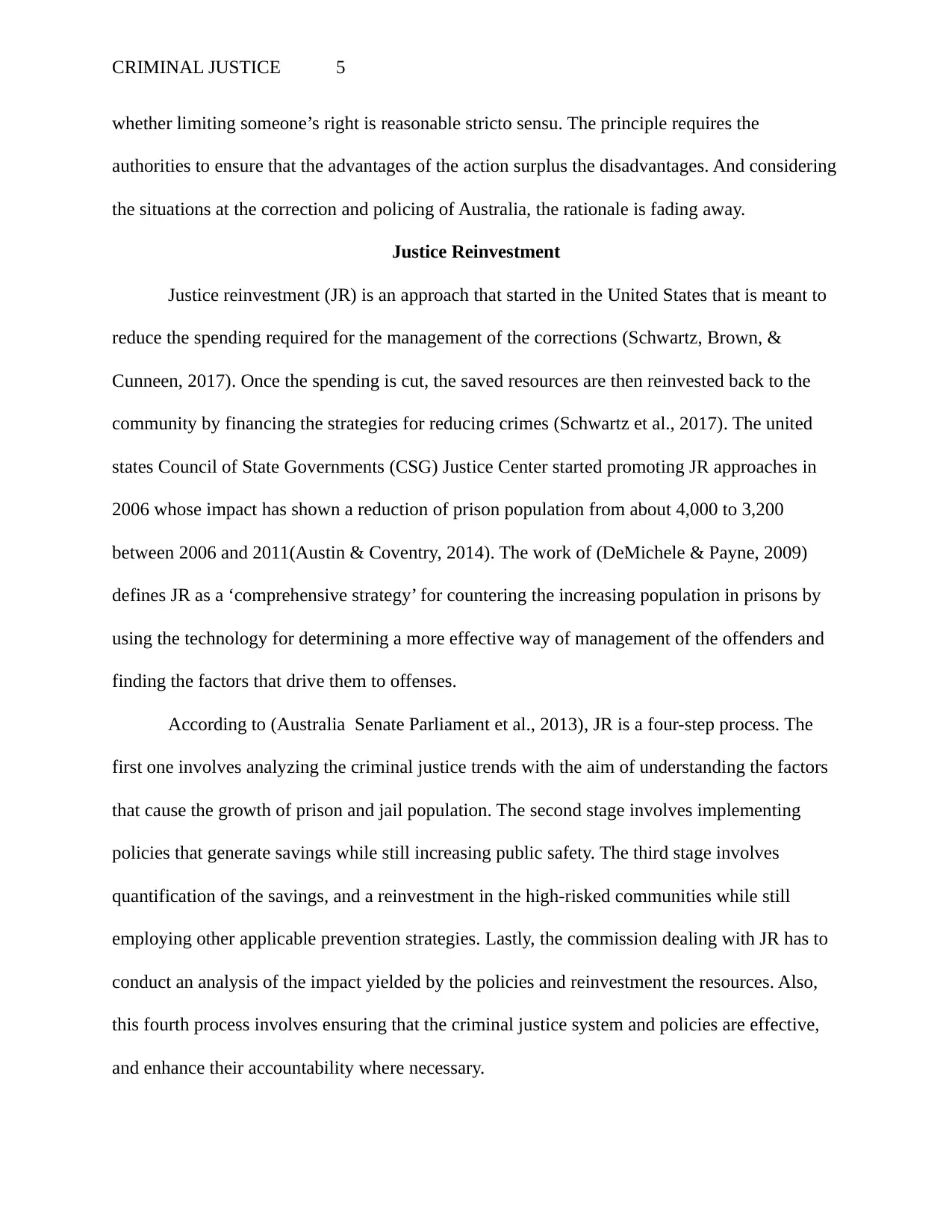
CRIMINAL JUSTICE 5
whether limiting someone’s right is reasonable stricto sensu. The principle requires the
authorities to ensure that the advantages of the action surplus the disadvantages. And considering
the situations at the correction and policing of Australia, the rationale is fading away.
Justice Reinvestment
Justice reinvestment (JR) is an approach that started in the United States that is meant to
reduce the spending required for the management of the corrections (Schwartz, Brown, &
Cunneen, 2017). Once the spending is cut, the saved resources are then reinvested back to the
community by financing the strategies for reducing crimes (Schwartz et al., 2017). The united
states Council of State Governments (CSG) Justice Center started promoting JR approaches in
2006 whose impact has shown a reduction of prison population from about 4,000 to 3,200
between 2006 and 2011(Austin & Coventry, 2014). The work of (DeMichele & Payne, 2009)
defines JR as a ‘comprehensive strategy’ for countering the increasing population in prisons by
using the technology for determining a more effective way of management of the offenders and
finding the factors that drive them to offenses.
According to (Australia Senate Parliament et al., 2013), JR is a four-step process. The
first one involves analyzing the criminal justice trends with the aim of understanding the factors
that cause the growth of prison and jail population. The second stage involves implementing
policies that generate savings while still increasing public safety. The third stage involves
quantification of the savings, and a reinvestment in the high-risked communities while still
employing other applicable prevention strategies. Lastly, the commission dealing with JR has to
conduct an analysis of the impact yielded by the policies and reinvestment the resources. Also,
this fourth process involves ensuring that the criminal justice system and policies are effective,
and enhance their accountability where necessary.
whether limiting someone’s right is reasonable stricto sensu. The principle requires the
authorities to ensure that the advantages of the action surplus the disadvantages. And considering
the situations at the correction and policing of Australia, the rationale is fading away.
Justice Reinvestment
Justice reinvestment (JR) is an approach that started in the United States that is meant to
reduce the spending required for the management of the corrections (Schwartz, Brown, &
Cunneen, 2017). Once the spending is cut, the saved resources are then reinvested back to the
community by financing the strategies for reducing crimes (Schwartz et al., 2017). The united
states Council of State Governments (CSG) Justice Center started promoting JR approaches in
2006 whose impact has shown a reduction of prison population from about 4,000 to 3,200
between 2006 and 2011(Austin & Coventry, 2014). The work of (DeMichele & Payne, 2009)
defines JR as a ‘comprehensive strategy’ for countering the increasing population in prisons by
using the technology for determining a more effective way of management of the offenders and
finding the factors that drive them to offenses.
According to (Australia Senate Parliament et al., 2013), JR is a four-step process. The
first one involves analyzing the criminal justice trends with the aim of understanding the factors
that cause the growth of prison and jail population. The second stage involves implementing
policies that generate savings while still increasing public safety. The third stage involves
quantification of the savings, and a reinvestment in the high-risked communities while still
employing other applicable prevention strategies. Lastly, the commission dealing with JR has to
conduct an analysis of the impact yielded by the policies and reinvestment the resources. Also,
this fourth process involves ensuring that the criminal justice system and policies are effective,
and enhance their accountability where necessary.
⊘ This is a preview!⊘
Do you want full access?
Subscribe today to unlock all pages.

Trusted by 1+ million students worldwide
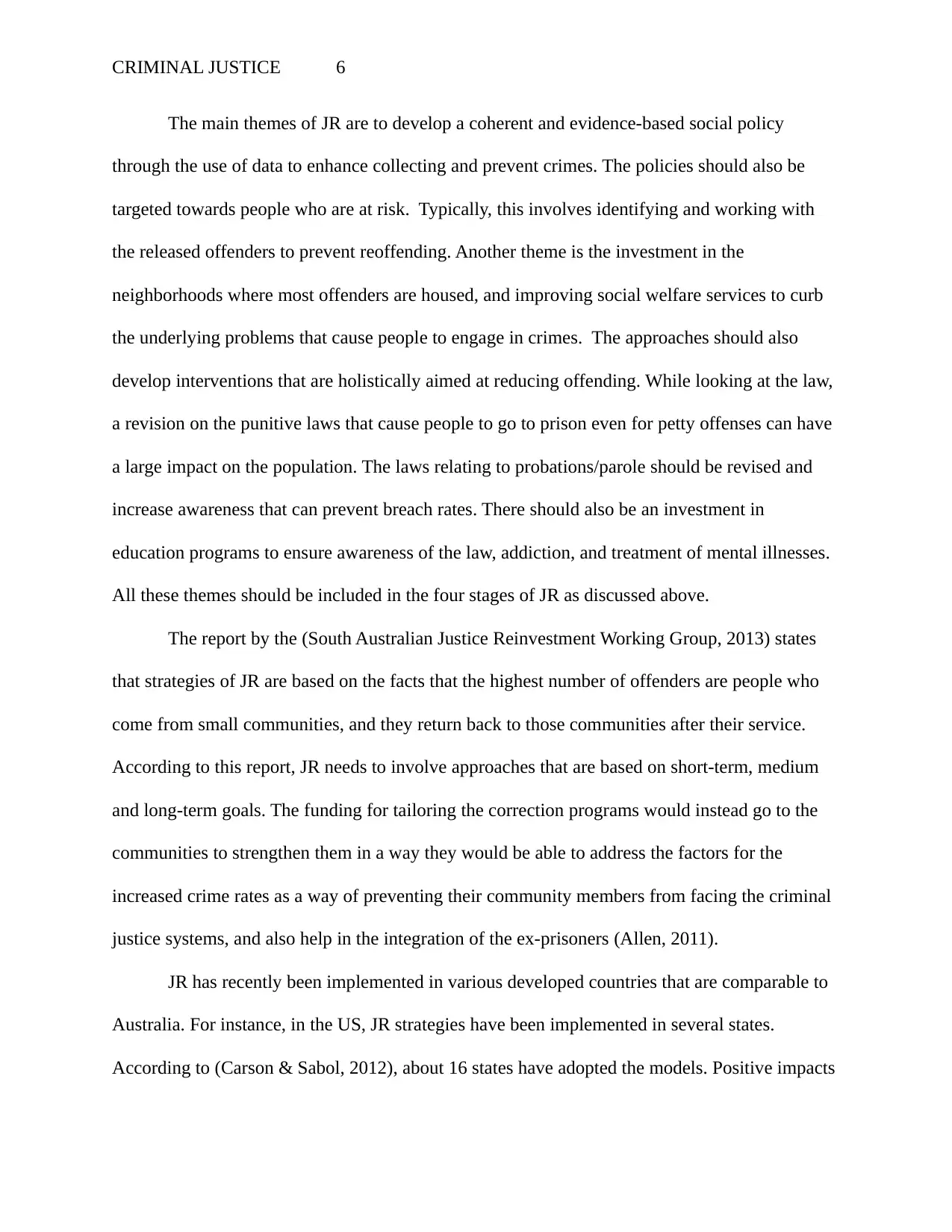
CRIMINAL JUSTICE 6
The main themes of JR are to develop a coherent and evidence-based social policy
through the use of data to enhance collecting and prevent crimes. The policies should also be
targeted towards people who are at risk. Typically, this involves identifying and working with
the released offenders to prevent reoffending. Another theme is the investment in the
neighborhoods where most offenders are housed, and improving social welfare services to curb
the underlying problems that cause people to engage in crimes. The approaches should also
develop interventions that are holistically aimed at reducing offending. While looking at the law,
a revision on the punitive laws that cause people to go to prison even for petty offenses can have
a large impact on the population. The laws relating to probations/parole should be revised and
increase awareness that can prevent breach rates. There should also be an investment in
education programs to ensure awareness of the law, addiction, and treatment of mental illnesses.
All these themes should be included in the four stages of JR as discussed above.
The report by the (South Australian Justice Reinvestment Working Group, 2013) states
that strategies of JR are based on the facts that the highest number of offenders are people who
come from small communities, and they return back to those communities after their service.
According to this report, JR needs to involve approaches that are based on short-term, medium
and long-term goals. The funding for tailoring the correction programs would instead go to the
communities to strengthen them in a way they would be able to address the factors for the
increased crime rates as a way of preventing their community members from facing the criminal
justice systems, and also help in the integration of the ex-prisoners (Allen, 2011).
JR has recently been implemented in various developed countries that are comparable to
Australia. For instance, in the US, JR strategies have been implemented in several states.
According to (Carson & Sabol, 2012), about 16 states have adopted the models. Positive impacts
The main themes of JR are to develop a coherent and evidence-based social policy
through the use of data to enhance collecting and prevent crimes. The policies should also be
targeted towards people who are at risk. Typically, this involves identifying and working with
the released offenders to prevent reoffending. Another theme is the investment in the
neighborhoods where most offenders are housed, and improving social welfare services to curb
the underlying problems that cause people to engage in crimes. The approaches should also
develop interventions that are holistically aimed at reducing offending. While looking at the law,
a revision on the punitive laws that cause people to go to prison even for petty offenses can have
a large impact on the population. The laws relating to probations/parole should be revised and
increase awareness that can prevent breach rates. There should also be an investment in
education programs to ensure awareness of the law, addiction, and treatment of mental illnesses.
All these themes should be included in the four stages of JR as discussed above.
The report by the (South Australian Justice Reinvestment Working Group, 2013) states
that strategies of JR are based on the facts that the highest number of offenders are people who
come from small communities, and they return back to those communities after their service.
According to this report, JR needs to involve approaches that are based on short-term, medium
and long-term goals. The funding for tailoring the correction programs would instead go to the
communities to strengthen them in a way they would be able to address the factors for the
increased crime rates as a way of preventing their community members from facing the criminal
justice systems, and also help in the integration of the ex-prisoners (Allen, 2011).
JR has recently been implemented in various developed countries that are comparable to
Australia. For instance, in the US, JR strategies have been implemented in several states.
According to (Carson & Sabol, 2012), about 16 states have adopted the models. Positive impacts
Paraphrase This Document
Need a fresh take? Get an instant paraphrase of this document with our AI Paraphraser
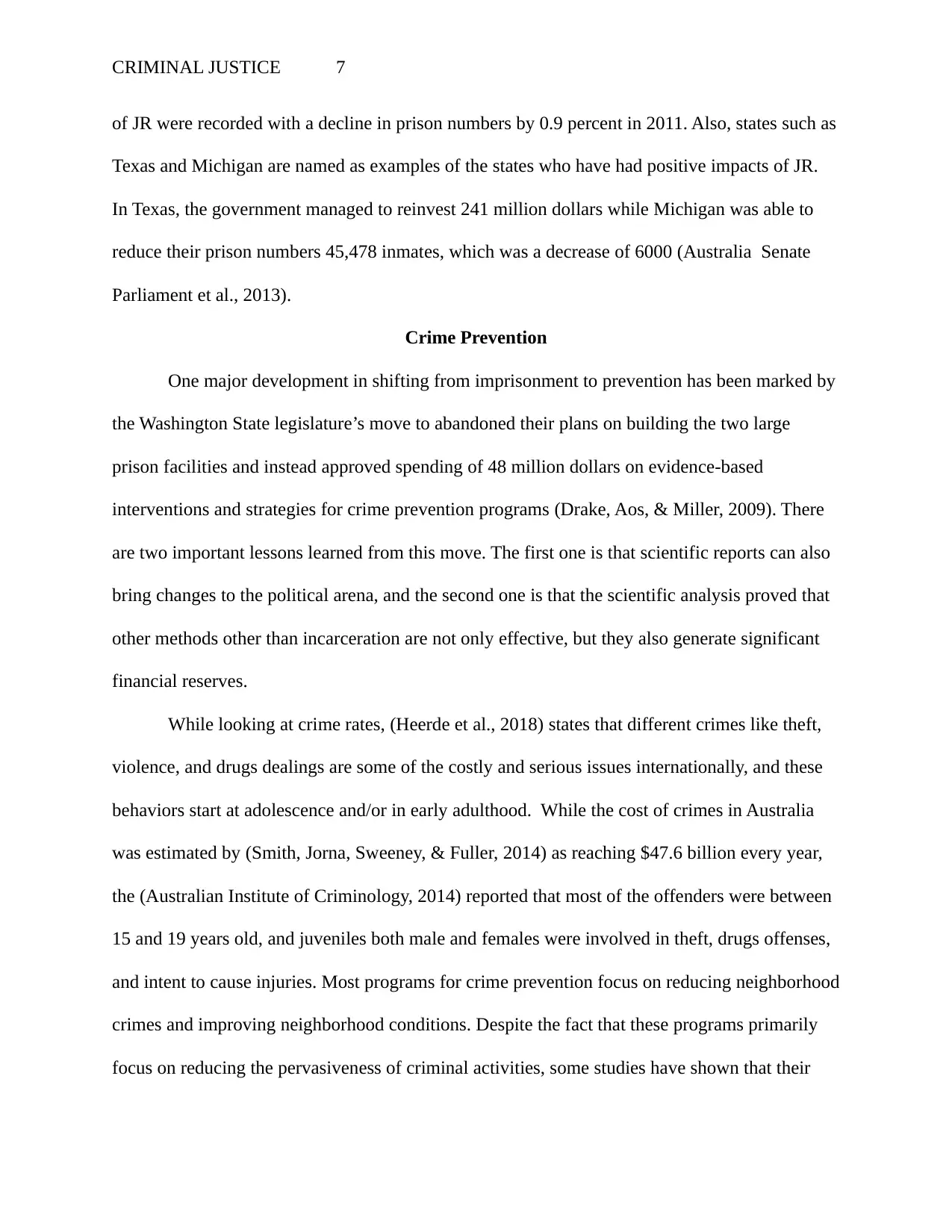
CRIMINAL JUSTICE 7
of JR were recorded with a decline in prison numbers by 0.9 percent in 2011. Also, states such as
Texas and Michigan are named as examples of the states who have had positive impacts of JR.
In Texas, the government managed to reinvest 241 million dollars while Michigan was able to
reduce their prison numbers 45,478 inmates, which was a decrease of 6000 (Australia Senate
Parliament et al., 2013).
Crime Prevention
One major development in shifting from imprisonment to prevention has been marked by
the Washington State legislature’s move to abandoned their plans on building the two large
prison facilities and instead approved spending of 48 million dollars on evidence-based
interventions and strategies for crime prevention programs (Drake, Aos, & Miller, 2009). There
are two important lessons learned from this move. The first one is that scientific reports can also
bring changes to the political arena, and the second one is that the scientific analysis proved that
other methods other than incarceration are not only effective, but they also generate significant
financial reserves.
While looking at crime rates, (Heerde et al., 2018) states that different crimes like theft,
violence, and drugs dealings are some of the costly and serious issues internationally, and these
behaviors start at adolescence and/or in early adulthood. While the cost of crimes in Australia
was estimated by (Smith, Jorna, Sweeney, & Fuller, 2014) as reaching $47.6 billion every year,
the (Australian Institute of Criminology, 2014) reported that most of the offenders were between
15 and 19 years old, and juveniles both male and females were involved in theft, drugs offenses,
and intent to cause injuries. Most programs for crime prevention focus on reducing neighborhood
crimes and improving neighborhood conditions. Despite the fact that these programs primarily
focus on reducing the pervasiveness of criminal activities, some studies have shown that their
of JR were recorded with a decline in prison numbers by 0.9 percent in 2011. Also, states such as
Texas and Michigan are named as examples of the states who have had positive impacts of JR.
In Texas, the government managed to reinvest 241 million dollars while Michigan was able to
reduce their prison numbers 45,478 inmates, which was a decrease of 6000 (Australia Senate
Parliament et al., 2013).
Crime Prevention
One major development in shifting from imprisonment to prevention has been marked by
the Washington State legislature’s move to abandoned their plans on building the two large
prison facilities and instead approved spending of 48 million dollars on evidence-based
interventions and strategies for crime prevention programs (Drake, Aos, & Miller, 2009). There
are two important lessons learned from this move. The first one is that scientific reports can also
bring changes to the political arena, and the second one is that the scientific analysis proved that
other methods other than incarceration are not only effective, but they also generate significant
financial reserves.
While looking at crime rates, (Heerde et al., 2018) states that different crimes like theft,
violence, and drugs dealings are some of the costly and serious issues internationally, and these
behaviors start at adolescence and/or in early adulthood. While the cost of crimes in Australia
was estimated by (Smith, Jorna, Sweeney, & Fuller, 2014) as reaching $47.6 billion every year,
the (Australian Institute of Criminology, 2014) reported that most of the offenders were between
15 and 19 years old, and juveniles both male and females were involved in theft, drugs offenses,
and intent to cause injuries. Most programs for crime prevention focus on reducing neighborhood
crimes and improving neighborhood conditions. Despite the fact that these programs primarily
focus on reducing the pervasiveness of criminal activities, some studies have shown that their
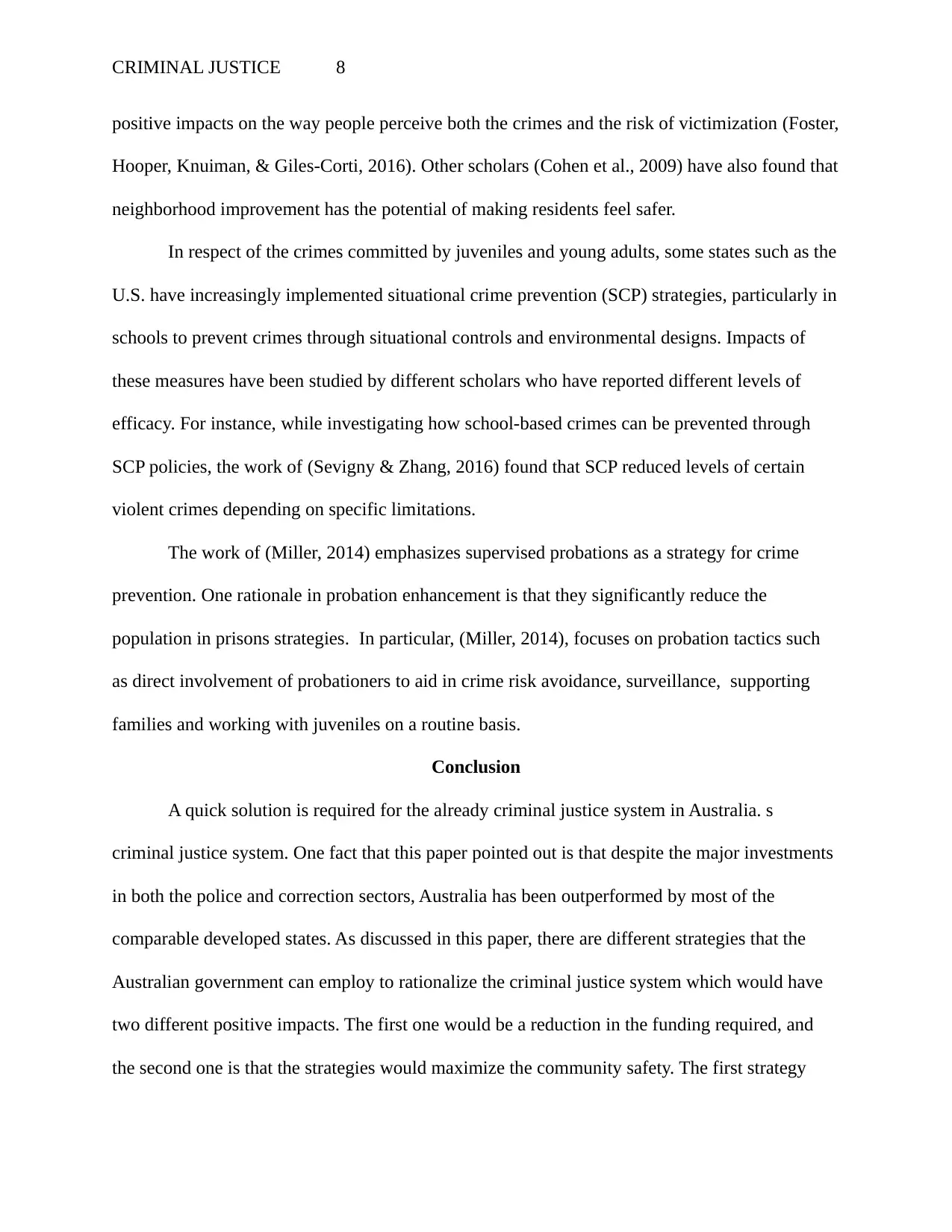
CRIMINAL JUSTICE 8
positive impacts on the way people perceive both the crimes and the risk of victimization (Foster,
Hooper, Knuiman, & Giles-Corti, 2016). Other scholars (Cohen et al., 2009) have also found that
neighborhood improvement has the potential of making residents feel safer.
In respect of the crimes committed by juveniles and young adults, some states such as the
U.S. have increasingly implemented situational crime prevention (SCP) strategies, particularly in
schools to prevent crimes through situational controls and environmental designs. Impacts of
these measures have been studied by different scholars who have reported different levels of
efficacy. For instance, while investigating how school-based crimes can be prevented through
SCP policies, the work of (Sevigny & Zhang, 2016) found that SCP reduced levels of certain
violent crimes depending on specific limitations.
The work of (Miller, 2014) emphasizes supervised probations as a strategy for crime
prevention. One rationale in probation enhancement is that they significantly reduce the
population in prisons strategies. In particular, (Miller, 2014), focuses on probation tactics such
as direct involvement of probationers to aid in crime risk avoidance, surveillance, supporting
families and working with juveniles on a routine basis.
Conclusion
A quick solution is required for the already criminal justice system in Australia. s
criminal justice system. One fact that this paper pointed out is that despite the major investments
in both the police and correction sectors, Australia has been outperformed by most of the
comparable developed states. As discussed in this paper, there are different strategies that the
Australian government can employ to rationalize the criminal justice system which would have
two different positive impacts. The first one would be a reduction in the funding required, and
the second one is that the strategies would maximize the community safety. The first strategy
positive impacts on the way people perceive both the crimes and the risk of victimization (Foster,
Hooper, Knuiman, & Giles-Corti, 2016). Other scholars (Cohen et al., 2009) have also found that
neighborhood improvement has the potential of making residents feel safer.
In respect of the crimes committed by juveniles and young adults, some states such as the
U.S. have increasingly implemented situational crime prevention (SCP) strategies, particularly in
schools to prevent crimes through situational controls and environmental designs. Impacts of
these measures have been studied by different scholars who have reported different levels of
efficacy. For instance, while investigating how school-based crimes can be prevented through
SCP policies, the work of (Sevigny & Zhang, 2016) found that SCP reduced levels of certain
violent crimes depending on specific limitations.
The work of (Miller, 2014) emphasizes supervised probations as a strategy for crime
prevention. One rationale in probation enhancement is that they significantly reduce the
population in prisons strategies. In particular, (Miller, 2014), focuses on probation tactics such
as direct involvement of probationers to aid in crime risk avoidance, surveillance, supporting
families and working with juveniles on a routine basis.
Conclusion
A quick solution is required for the already criminal justice system in Australia. s
criminal justice system. One fact that this paper pointed out is that despite the major investments
in both the police and correction sectors, Australia has been outperformed by most of the
comparable developed states. As discussed in this paper, there are different strategies that the
Australian government can employ to rationalize the criminal justice system which would have
two different positive impacts. The first one would be a reduction in the funding required, and
the second one is that the strategies would maximize the community safety. The first strategy
⊘ This is a preview!⊘
Do you want full access?
Subscribe today to unlock all pages.

Trusted by 1+ million students worldwide
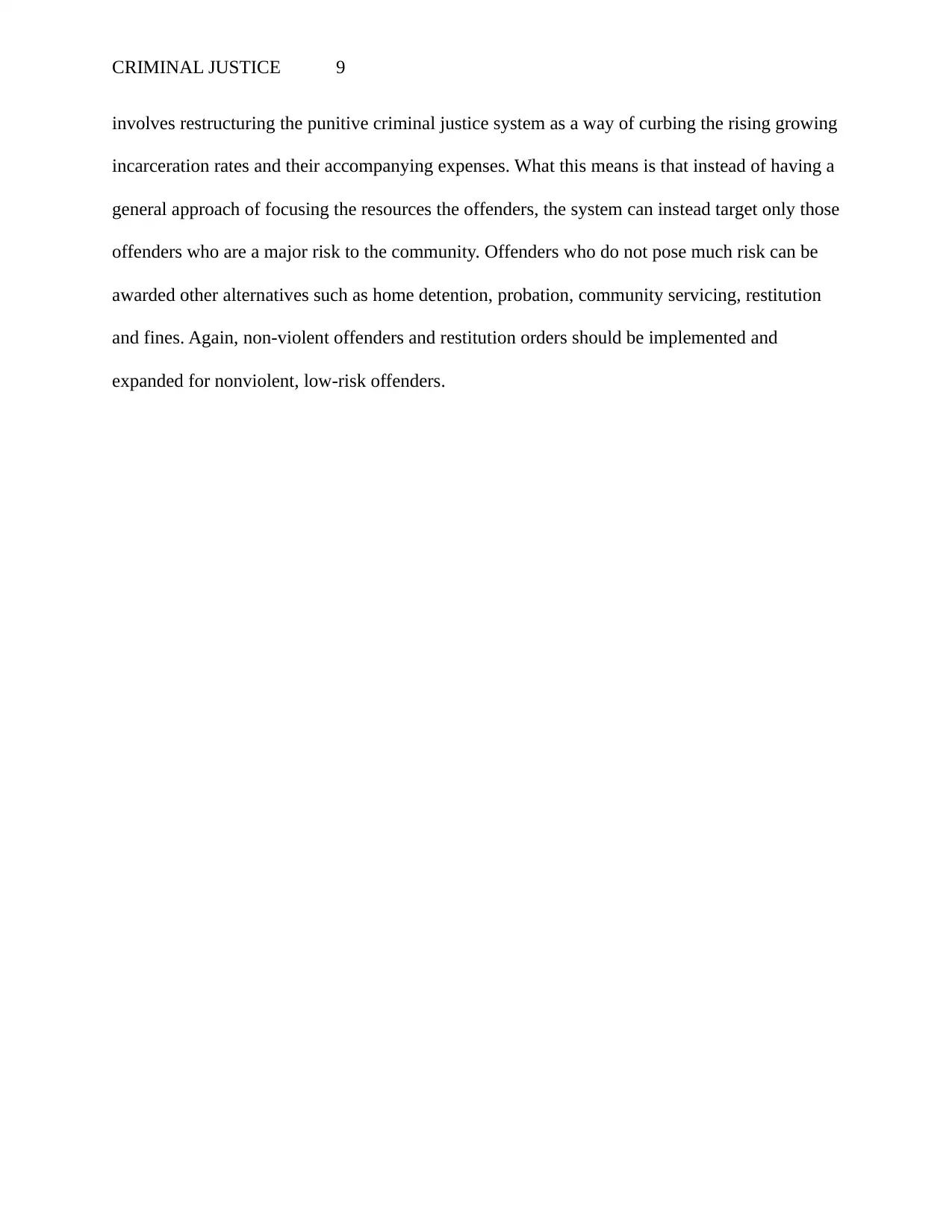
CRIMINAL JUSTICE 9
involves restructuring the punitive criminal justice system as a way of curbing the rising growing
incarceration rates and their accompanying expenses. What this means is that instead of having a
general approach of focusing the resources the offenders, the system can instead target only those
offenders who are a major risk to the community. Offenders who do not pose much risk can be
awarded other alternatives such as home detention, probation, community servicing, restitution
and fines. Again, non-violent offenders and restitution orders should be implemented and
expanded for nonviolent, low-risk offenders.
involves restructuring the punitive criminal justice system as a way of curbing the rising growing
incarceration rates and their accompanying expenses. What this means is that instead of having a
general approach of focusing the resources the offenders, the system can instead target only those
offenders who are a major risk to the community. Offenders who do not pose much risk can be
awarded other alternatives such as home detention, probation, community servicing, restitution
and fines. Again, non-violent offenders and restitution orders should be implemented and
expanded for nonviolent, low-risk offenders.
Paraphrase This Document
Need a fresh take? Get an instant paraphrase of this document with our AI Paraphraser

CRIMINAL JUSTICE 10
References
Allen, R. (2011). Justice reinvestment and the use of imprisonment: Policy reflections from
England and Wales. Criminology & Public Policy, 10(3), 617–627.
Austin, J., & Coventry, G. (2014). A Critical Analysis of Justice Reinvestment in the United
States and Australia. Victims & Offenders, 9(1), 126–148.
https://doi.org/10.1080/15564886.2014.861687
Australia Senate Parliament, Legal and Constitutional Affairs References Committee, & Wright,
P. (2013). Value of a justice reinvestment approach to criminal justice in Australia.
Canberra: The Commonwealth of Australia.
Australian Bureau of Statistics. (2017). Prisoners in Australia. Retrieved from
http://www.abs.gov.au/ausstats/abs@.nsf/mf/4517.0
Australian Institute of Criminology. (2014). Australian Crime: Facts & Figures 2014. Canberra:
Australian Institute of Criminology. Retrieved from
https://aic.gov.au/publications/facts/2014
Bendor, A. L., & Sela, T. (2015). How proportional is proportionality? International Journal of
Constitutional Law, 13(2), 530–544. https://doi.org/10.1093/icon/mov028
Bushnell, A. (2017). Australia’s Criminal Justice Costs an International Comparison. Retrieved
from https://ipa.org.au/wp-content/uploads/2017/08/IPA-Report-Australian-Criminal-
Justice-Costs-An-International-Comparison.pdf
Clear, T. R., & Austin, J. (2009). Reducing mass incarceration: Implications of the iron law of
prison populations. Harv. L. & Pol’y Rev., 3, 307.
Clear, T. R., Cole, G. F., & Reisig, M. D. (2011). American corrections (9th ed). Belmont, CA:
Wadsworth Cengage Learning.
References
Allen, R. (2011). Justice reinvestment and the use of imprisonment: Policy reflections from
England and Wales. Criminology & Public Policy, 10(3), 617–627.
Austin, J., & Coventry, G. (2014). A Critical Analysis of Justice Reinvestment in the United
States and Australia. Victims & Offenders, 9(1), 126–148.
https://doi.org/10.1080/15564886.2014.861687
Australia Senate Parliament, Legal and Constitutional Affairs References Committee, & Wright,
P. (2013). Value of a justice reinvestment approach to criminal justice in Australia.
Canberra: The Commonwealth of Australia.
Australian Bureau of Statistics. (2017). Prisoners in Australia. Retrieved from
http://www.abs.gov.au/ausstats/abs@.nsf/mf/4517.0
Australian Institute of Criminology. (2014). Australian Crime: Facts & Figures 2014. Canberra:
Australian Institute of Criminology. Retrieved from
https://aic.gov.au/publications/facts/2014
Bendor, A. L., & Sela, T. (2015). How proportional is proportionality? International Journal of
Constitutional Law, 13(2), 530–544. https://doi.org/10.1093/icon/mov028
Bushnell, A. (2017). Australia’s Criminal Justice Costs an International Comparison. Retrieved
from https://ipa.org.au/wp-content/uploads/2017/08/IPA-Report-Australian-Criminal-
Justice-Costs-An-International-Comparison.pdf
Clear, T. R., & Austin, J. (2009). Reducing mass incarceration: Implications of the iron law of
prison populations. Harv. L. & Pol’y Rev., 3, 307.
Clear, T. R., Cole, G. F., & Reisig, M. D. (2011). American corrections (9th ed). Belmont, CA:
Wadsworth Cengage Learning.
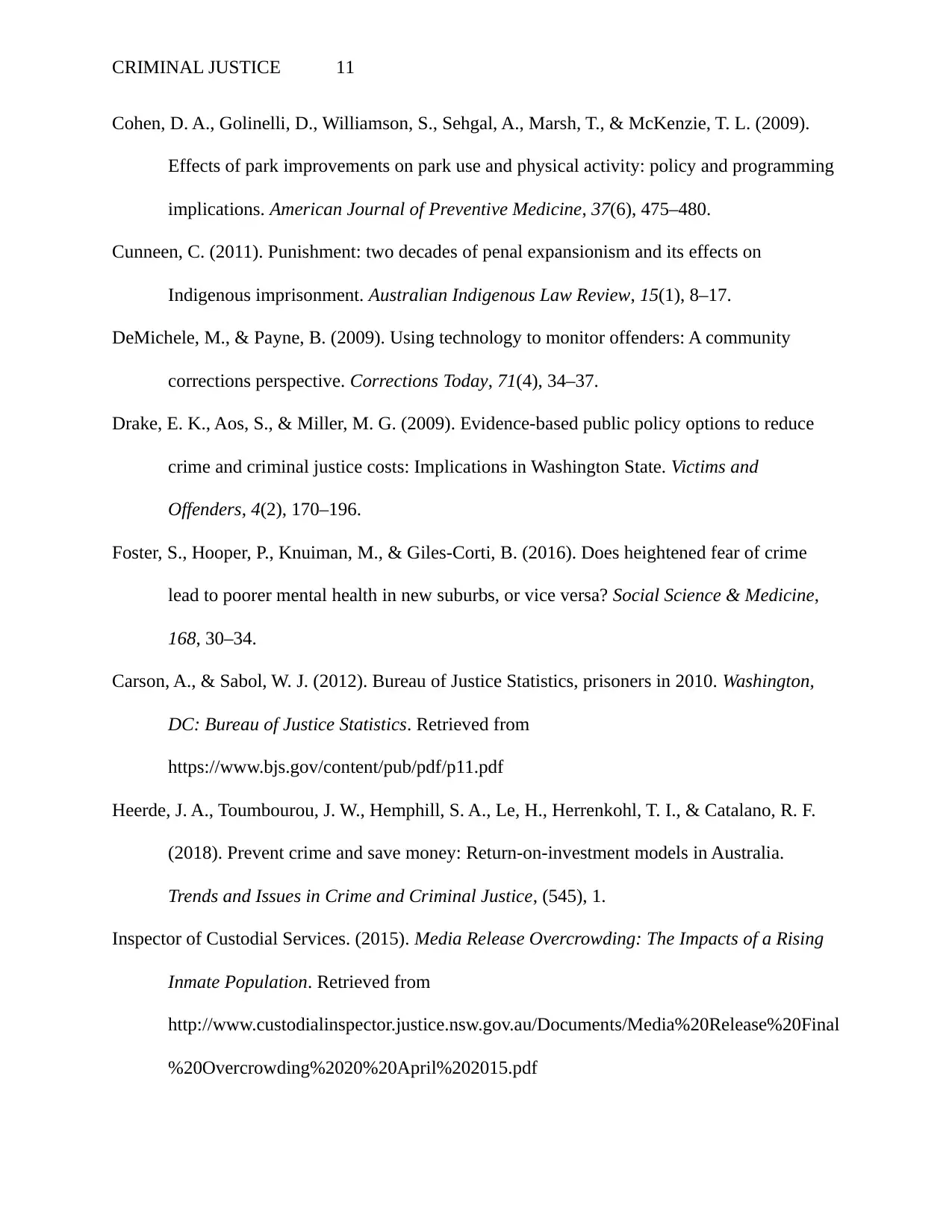
CRIMINAL JUSTICE 11
Cohen, D. A., Golinelli, D., Williamson, S., Sehgal, A., Marsh, T., & McKenzie, T. L. (2009).
Effects of park improvements on park use and physical activity: policy and programming
implications. American Journal of Preventive Medicine, 37(6), 475–480.
Cunneen, C. (2011). Punishment: two decades of penal expansionism and its effects on
Indigenous imprisonment. Australian Indigenous Law Review, 15(1), 8–17.
DeMichele, M., & Payne, B. (2009). Using technology to monitor offenders: A community
corrections perspective. Corrections Today, 71(4), 34–37.
Drake, E. K., Aos, S., & Miller, M. G. (2009). Evidence-based public policy options to reduce
crime and criminal justice costs: Implications in Washington State. Victims and
Offenders, 4(2), 170–196.
Foster, S., Hooper, P., Knuiman, M., & Giles-Corti, B. (2016). Does heightened fear of crime
lead to poorer mental health in new suburbs, or vice versa? Social Science & Medicine,
168, 30–34.
Carson, A., & Sabol, W. J. (2012). Bureau of Justice Statistics, prisoners in 2010. Washington,
DC: Bureau of Justice Statistics. Retrieved from
https://www.bjs.gov/content/pub/pdf/p11.pdf
Heerde, J. A., Toumbourou, J. W., Hemphill, S. A., Le, H., Herrenkohl, T. I., & Catalano, R. F.
(2018). Prevent crime and save money: Return-on-investment models in Australia.
Trends and Issues in Crime and Criminal Justice, (545), 1.
Inspector of Custodial Services. (2015). Media Release Overcrowding: The Impacts of a Rising
Inmate Population. Retrieved from
http://www.custodialinspector.justice.nsw.gov.au/Documents/Media%20Release%20Final
%20Overcrowding%2020%20April%202015.pdf
Cohen, D. A., Golinelli, D., Williamson, S., Sehgal, A., Marsh, T., & McKenzie, T. L. (2009).
Effects of park improvements on park use and physical activity: policy and programming
implications. American Journal of Preventive Medicine, 37(6), 475–480.
Cunneen, C. (2011). Punishment: two decades of penal expansionism and its effects on
Indigenous imprisonment. Australian Indigenous Law Review, 15(1), 8–17.
DeMichele, M., & Payne, B. (2009). Using technology to monitor offenders: A community
corrections perspective. Corrections Today, 71(4), 34–37.
Drake, E. K., Aos, S., & Miller, M. G. (2009). Evidence-based public policy options to reduce
crime and criminal justice costs: Implications in Washington State. Victims and
Offenders, 4(2), 170–196.
Foster, S., Hooper, P., Knuiman, M., & Giles-Corti, B. (2016). Does heightened fear of crime
lead to poorer mental health in new suburbs, or vice versa? Social Science & Medicine,
168, 30–34.
Carson, A., & Sabol, W. J. (2012). Bureau of Justice Statistics, prisoners in 2010. Washington,
DC: Bureau of Justice Statistics. Retrieved from
https://www.bjs.gov/content/pub/pdf/p11.pdf
Heerde, J. A., Toumbourou, J. W., Hemphill, S. A., Le, H., Herrenkohl, T. I., & Catalano, R. F.
(2018). Prevent crime and save money: Return-on-investment models in Australia.
Trends and Issues in Crime and Criminal Justice, (545), 1.
Inspector of Custodial Services. (2015). Media Release Overcrowding: The Impacts of a Rising
Inmate Population. Retrieved from
http://www.custodialinspector.justice.nsw.gov.au/Documents/Media%20Release%20Final
%20Overcrowding%2020%20April%202015.pdf
⊘ This is a preview!⊘
Do you want full access?
Subscribe today to unlock all pages.

Trusted by 1+ million students worldwide
1 out of 14
Related Documents
Your All-in-One AI-Powered Toolkit for Academic Success.
+13062052269
info@desklib.com
Available 24*7 on WhatsApp / Email
![[object Object]](/_next/static/media/star-bottom.7253800d.svg)
Unlock your academic potential
Copyright © 2020–2025 A2Z Services. All Rights Reserved. Developed and managed by ZUCOL.




